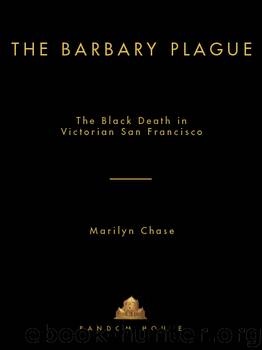The Barbary Plague by Marilyn Chase

Author:Marilyn Chase [Chase, Marilyn]
Language: eng
Format: epub
ISBN: 978-1-58836-285-8
Publisher: Random House Publishing Group
Published: 2003-06-14T16:00:00+00:00
Earthquake
AT 5:12 A.M. ON WEDNESDAY, April 18, 1906, the ground beneath San Francisco convulsed. There was a groan of grinding mortar and a thunder of raining brick and stone. Twisting timber shrieked and snapped into splintered kindling. After forty-five seconds, the roiling paused a moment, and then a second shock wave hit, more violent than the first.1
From a hundred thousand fractured rooms came cries of shock and pain. Sleepers, hurled from their beds, threw coats over night-clothes, grabbed children, and poured into the street. Some yanked frantically on bedroom doors, trapped in shifting frames that no longer fit. Buildings listed drunkenly off their foundations. Wooden cottages collapsed like houses of cards, rows of flats like dominoes. Brick facades peeled off and crashed into the street, exposing what looked like a doll’s house. Streetcar tracks buckled in serpentine snarls.
South of Market Street, where tracts sat precariously on landfill, the ground liquefied over ancient waterfront and wetlands. The four-story Valencia Hotel, a working-class lodging house, sank into its fluid foundation. With only its top story protruding above ground, lodgers on the lower floors were submerged and drowned.
Dozens of small fires burst from toppled chimneys and cracked stove flues. Fire alarms stayed strangely silent. The alarm center on Brenham Place had been destroyed. At one station, fire horses bolted in fear, so firefighters had to tow their engines by hand. When they hooked up their hoses, only droplets trickled out, so the firefighters siphoned leaky sewage to spray on the flames.
Steers being herded to the Potrero stockyards were spooked by the shaking and stampeded along Mission Street. To avoid being trampled, bystanders shot the crazed cattle between the eyes.
On Merchant Street, near the federal morgue and laboratory, fish dealer Alex Paladini was unloading the morning’s catch when the earthquake disintegrated buildings around him, burying horses, drivers, wagons, and fish under tons of bricks and mortar. The steeds’ necks protruded from the debris, their manes caked with dust, tongues lolling. The neighborhood around the morgue was now one giant street of the dead.
The ground shock savaged City Hall. Its regal dome teetered on empty ribs. All around it stretched acres of rubble. Before the day was over, flames devoured municipal records, incinerating all city history before 1906.
Mayor Eugene Schmitz, who had been reelected despite an ongoing graft probe, now played his role with cool command. He closed the saloons. He imposed a curfew from dark until dawn. When rioters raided liquor and cigar shops, he issued an executive order for federal troops and police to shoot looters on sight. From the ruins of City Hall, he moved the seat of government to the Hall of Justice on Kearny Street, then to the Fairmont Hotel, then to a hall in the Western Addition, keeping one step ahead of the flames.
Schmitz wired the mayor of Oakland, demanding hoses and dynamite. From the capital in Sacramento, Governor George Pardee boarded a train toward the stricken city, setting up his base of operations in Oakland, where phone and wire service remained intact.
Download
This site does not store any files on its server. We only index and link to content provided by other sites. Please contact the content providers to delete copyright contents if any and email us, we'll remove relevant links or contents immediately.
| Administration & Medicine Economics | Allied Health Professions |
| Basic Sciences | Dentistry |
| History | Medical Informatics |
| Medicine | Nursing |
| Pharmacology | Psychology |
| Research | Veterinary Medicine |
The Immortal Life of Henrietta Lacks by Rebecca Skloot(4525)
An American Plague by Jim Murphy(3711)
The Emperor of All Maladies: A Biography of Cancer by Siddhartha Mukherjee(3067)
The Gene: An Intimate History by Siddhartha Mukherjee(3047)
The Fate of Rome: Climate, Disease, and the End of an Empire (The Princeton History of the Ancient World) by Kyle Harper(3003)
Rebecca Skloot by The Immortal Life of Henrietta Lacks(1978)
Stiff - The Curious Lives of Human Cadavers by Mary Roach(1814)
The Great Influenza by John M Barry(1750)
The Vaccine Race by Meredith Wadman(1629)
Undue Risk by Moreno Jonathan D.;(1600)
Hero by Michael Grant(1586)
Three Cups of Tea by Greg Mortenson(1577)
The Mystery of the Exploding Teeth by Thomas Morris(1540)
Quackery by Lydia Kang(1519)
Autism's False Prophets by Paul A. Offit(1496)
Extremes: Life, Death and the Limits of the Human Body by Fong Kevin(1484)
A Journal of the Plague Year (Oxford World's Classics) by Daniel Defoe(1483)
Steroids: History, Science, and Issues by Standora Joan E.; Bogomolnik Alex; Slugocki Malgorzata(1479)
The Vaccine Court by Rohde Wayne(1471)
